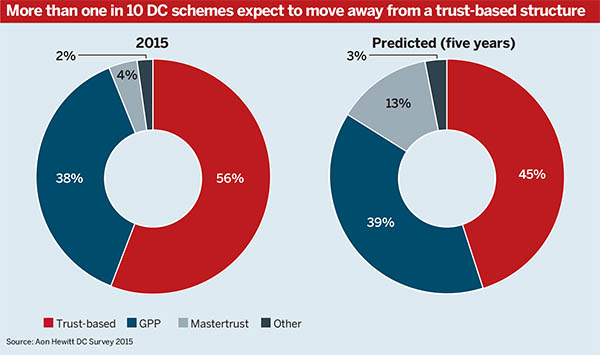Analysis: For as long as the term 'independent governance committee' has been floating around the pensions industry there have been questions about how they will work.
Academics have called for IGCs to resemble trustee boards, and politicians have criticised the potential for conflicts of interest.
Providers responded by filling committees with high-profile members of the industry, but the real test of whether they are fit for purpose comes with the release of their first reports.
The typical scheme member doesn’t wake up in the morning thinking about pensions
Laurie Edmans, Zurich IGC
Over the past few weeks IGCs have begun to release their first reports detailing how they are protecting and advancing the best interests of members.
However, with four reports now out it is becoming clear there is little unanimity in how IGCs have approached the question of value for money.
All providers are required to report by April 6, with providers Royal London, Prudential, Legal & General and Zurich reporting already.
More are expected to come forward this week, but what can be learned from what we have seen so far? And what can we expect from IGCs in the future?
Member focus
The question of how to define value has been testing the industry more widely since the introduction of the 75 basis points charge cap on auto-enrolment default schemes, with many claiming the lower cost can lead to providers and asset managers simply offering less sophisticated products to defined contribution schemes.
In its final rules for IGCs, released in February last year, the Financial Conduct Authority said it would not mandate a specific approach to defining value for money, “given the very different characteristics of different providers’ schemes”.

The result is a panoply of approaches for assessing. Legal & General issued a document detailing its seven-part process for assessing value, Zurich is conducting consumer research to learn how its members define value for money and Prudential has benchmarks for investment performance and charges to assess.
Laurie Edmans, chair of the Zurich IGC, says the value-for-money question should focus on members.
“The key thing is whether or not the member got the outcome that they think is value for money,” he says.
“We’re going to have a definition of value for money where we can say, ‘This is what our members think’... Most of the analyses of value for money don’t go anywhere near the rather philosophical side of it.”
He adds that the IGC would look to speak to members who had reached retirement to find out what their experience has been.
Edmans says the Zurich IGC aims to get a view that is attributable to members, although he admitted engagement could be a challenge to the process.
“The typical scheme member doesn’t wake up in the morning thinking about pensions.”
Concrete definitions
Lawrence Churchill, chair of the Prudential IGC, on the other hand says members “aren’t going to be interested” in more esoteric definitions and will prefer something concrete.
The IGC has used a benchmark of CPI +3 per cent a year after charges to judge value for money in investments.
It also has a 75bp benchmark for charges to auto enrolment schemes – in line with the Department for Work and Pensions’ limits – a 100bp limit for unit-linked schemes not used for auto-enrolment and 125bp for with-profits investments, “where the benefits of smoothing and guarantees bring extra value to members”.
Collaboration
Despite being focused on members of their associated company’s schemes, experts say that over the longer term, IGCs will likely increase their level of collaboration.
Paul Trickett, head of the Legal & General IGC, says: “Year-one our focus is on... making sure people have access to value for money.”
He adds that committees “all might have different definitions of what that means”.
However, he said in the longer term they are “looking to get some cross-industry comparisons, benchmarking across the industry.”
“It’s a project that is likely to get some steam through the year,” he adds.
Churchill agrees, but said commercial concerns limit some of the discussions.
“The IGC chairs do talk to each other,” he says, but warns: “We have to be very careful what we talk about.”
Helen Ball, partner at law firm Sackers, agrees, saying IGCs should be cautious “because there are all kinds of rules around sensitive commercial information that they are able to share”.
Agents of change
Ball adds that despite initial concerns, IGCs are showing themselves to be independent of the providers. “They’re not just agreeing with what the provider says.”
The Royal London IGC succeeded in the removal of a number of member charges and penalties, as well as removing caps on loyalty bonus payments for members.
The committee’s report says this will reduce overall charges on legacy workplace pension contracts by 20 per cent and cost the company £15m.
Prudential has also planned a schedule of changes, including a cap on policy fees from the end of May, followed by the reduction or removal of commission charges on all unit-linked or with-profits business
Churchill says while all of the with-profits and auto-enrolment policies already fall within the value-for-money framework set, some 8,000 of the others had charges above the benchmarks, half of them from small pots of less than £10,000.
“Prudential came to us with ideas for how they would bring them down,” he says.
In June, the company will engage with the policyholders to ensure they understand their situation and help find a solution such as transferring out or – if they are over 55 – other options for withdrawal.
Churchill says the committee’s priorities going forward are to monitor progress of the plan on an ongoing basis, to address the default investments of some of the legacy policies, and to work on communication with members.














